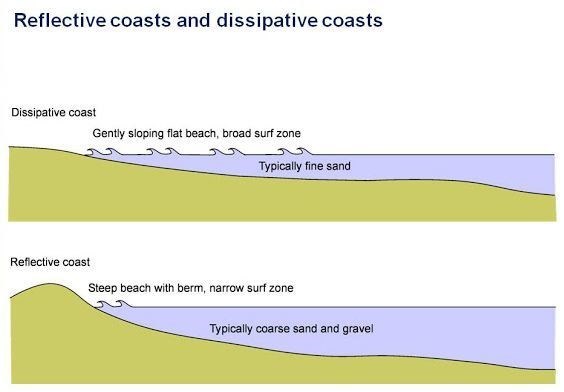Grand Anse Beach - Grenada
A day at the beach - isn't it wonderful ?
But let's have a closer look

Beach
Beaches are formed by constantly moving water that erodes the land located around.
Rivers and rainwaters may erode rocks located further inland as well.
These eroded sediments are deposited along the coastline, forming a beach.
The sediments may be sand, rock, shell, or pebbles.
The two basic beach types are dissipative and reflective:
The reflective type occurs when conditions are calm and/or the sediment is coarse.
Reflective beaches have the lowest wave energy of the wave-dominated beaches.
They are characterised by a relatively steep narrow beach face, composed of coarse sand.
Waves break close to the shore on a reflective beach with little prior loss of energy; this is a result of the steep beach face and deep nearshore zone.
When wave action is strong and/or sediment particle size is fine, the dissipative beach type is created.
This type has a flat and maximally eroded beach. The sediments are stored in a broad surf zone that may have multiple sandbanks parallel to the beach.

Sand
Sand is made of loose sedimentary rock, its grains' dimension must be between 0,063 and 2 mm, and it comes from the disintegration of other rocks.
Sand can be formed by the action of waves on the beaches, it represents the finest elements, gravels being larger than sand, but inferior to pebbles. Beaches and dunes are the most visible sand formations.
The two main types of materials in the sand of the beaches are quartz (silica) of terrestrial origin and carbonate material of marine origin. Carbonated material comes from the wear and tear of mollusk shells and skeletons from other animals. There is also a smaller quantity of other materials that include heavy minerals, such as volcanic basalt and feldspar.

To log your find, please send me a Mail with the answers to the following questions.
There is no information board, you have to answer the questions by your own observation.
1. What type of beach is this, dissipative or reflective? Explain your answer.
2. What is the average size of the sand grains of this beach ?
Look at the graphic and try to classify the sand :
Very coarse, Coarse, Medium, Fine or Very fine sand ?
3. What is the main color of the sand of this beach ?
4. Are there any other colors ?
Is the sediment mono (only one type of material) or
multimineralic (more than one type of material)?
Photos are welcome but optional
You can log your find after sending me a Mail with your answers.
You don‘t have to wait for my reply, I will contact you if something is wrong.
Logs without any answers will be deleted.